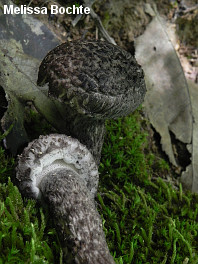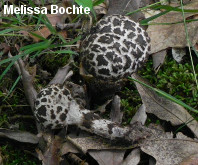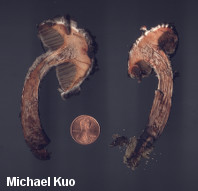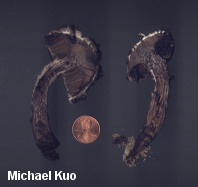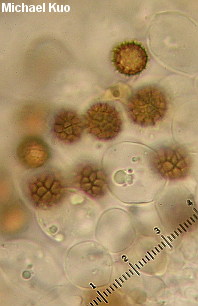| Major Groups > Boletes > Strobilomyces > Strobilomyces "floccopus" |

|
Strobilomyces "floccopus": The Old Man of the Woods [ Basidiomycota > Boletales > Boletaceae > Strobilomyces . . . ] by Michael Kuo . . . for the satirical rogue says here that old men have grey beards, that their faces are wrinkled, their eyes purging thick amber or plum-tree gum, and that they have a plentiful lack of wit, together with weak hams . . . This is Hamlet's description of his girlfriend's father, Strobilomyces polonius, but it works reasonably well for the "Old Man of the Woods" as well. How this mushroom got its oddly appropriate common name is unclear to me. I can find no one using it in turn-of-the-century mushroom treatises, or in the first half of (what has just become) the last century. The scientific name, Strobilomyces floccopus, roughly translated, means "wooly mushroom that looks like a pine cone"--rather more accurate as a descriptor, perhaps, but less interesting. As late as 1936, mushroom authors are using interpretations of the scientific name as "common" names; Krieger calls it the "cone-like boletus" in The Mushroom Handbook, and William Thomas calls it the "pine cone mushroom" in Field Book of Common Mushrooms. The first reference to the "Old Man of the Woods" I have seen is in the 1963 edition of Smith's The Mushroom Hunter's Field Guide. The Old Man is prominently wooly and scaly, a mixture of black and white and gray, and, overall, rather unkempt. If you're feeling particularly sadistic, slice the Old Man open and watch the flesh turn pinkish red, then slowly blacken over the course of an hour or so. With this combination of features, you'll know what this mushroom is the first time you find it--at least, in a "field guide-ish" sense. There are actually several species involved, including Strobilomyces confusus and Strobilomyces species 01 (see the key to Strobilomyces for help separating them). If you are wondering why I have placed "floccopus" in quotation marks, you can thank Ron Petersen and collaborators (2012), who used morphological analysis and DNA testing to determine not only that Europe's "Strobilomyces floccopus" was actually the same thing as the earlier-named Strobilomyces strobilaceus, but also that our North American old men do not match the European old men--which leaves our continent's mushroom (or "mushrooms?") without a name. Until a name is provided, I've decided to use "floccopus," in the sense of North American authors, and to use the quotation marks to indicate the shaky status of the name. Description: Ecology: Mycorrhizal with hardwoods, especially oaks; common; summer and fall; primarily distributed in eastern North America but also recorded from the Southwest. Cap: 3-15 cm; convex becoming broadly convex in age; dry; covered with large, black, soft, woolly scales over a whitish to grayish base color; the margin frequently with hanging remnants of a whitish to grayish partial veil. Pore Surface: Whitish, becoming gray to black; bruising red, then black; pores angular, 1-3 per mm; tubes to 2 cm deep. Stem: 4-12 cm long; 1-2.5 cm thick; more or less equal; grayish to blackish; shaggy; sometimes reticulate near the apex; often with an ephemeral ring or ring zone; solid. Flesh: Whitish throughout, turning pinkish to red when exposed, then blackening over the course of an hour. Odor and Taste: Not distinctive. Chemical Reactions: Ammonia yellowish to negative on flesh. KOH reddish, then brownish orangish on flesh. Iron salts bluish gray to greenish on flesh. Spore Print: Blackish brown to black. Microscopic Features: Spores 7-15 x 7-12 µ (including ornamentation); globose to broadly ellipsoid; with ornamentation of ridges and lines forming a complete reticulum. Pleurocystidia abundant; 17-90 x 8-26 µ; fusiform to mucronate; with brown contents. Pileipellis a trichoderm with cylindric terminal elements 4-18 µ wide. REFERENCES: (Vahl, 1797) Karsten, 1882. (Saccardo, 1888; Coker & Beers, 1943; Snell & Dick, 1970; Smith & Thiers, 1971; Smith, Smith & Weber, 1981; Arora, 1986; Phillips, 1991/2005; Lincoff, 1992; Both, 1993; Barron, 1999; Bessette, Roody & Bessette, 2000; Roody, 2003; McNeil, 2006; Kuo, 2007; Ortiz-Santana et al., 2007; Binion et al., 2008; Kuo & Methven, 2014.) Herb. Kuo 07079503, 06200201, 07210705. This site contains no information about the edibility or toxicity of mushrooms. |
© MushroomExpert.Com |
|
Cite this page as: Kuo, M. (2013, December). Strobilomyces "floccopus": The old man of the woods. Retrieved from the MushroomExpert.Com Web site: http://www.mushroomexpert.com/strobilomyces_floccopus.html |
